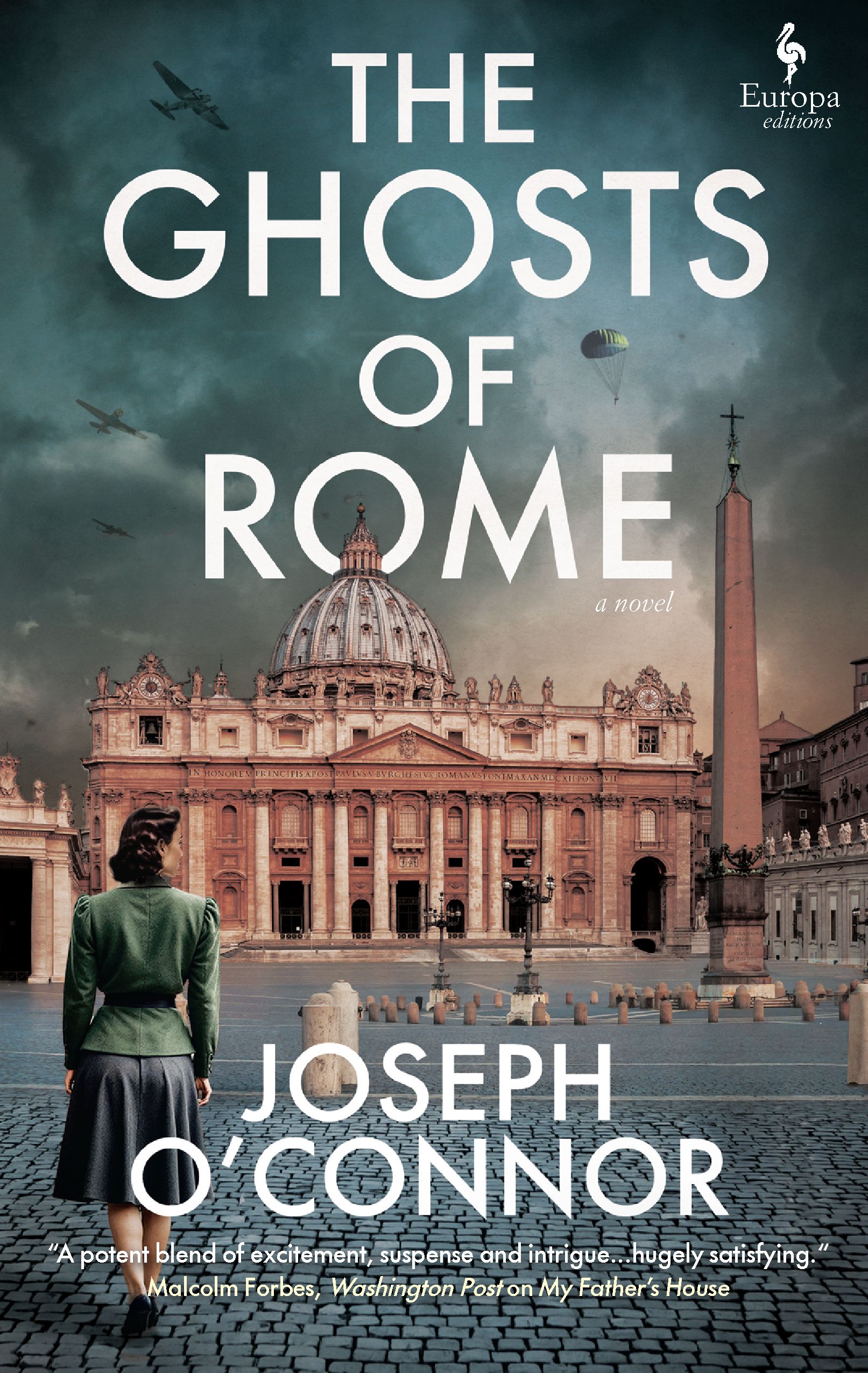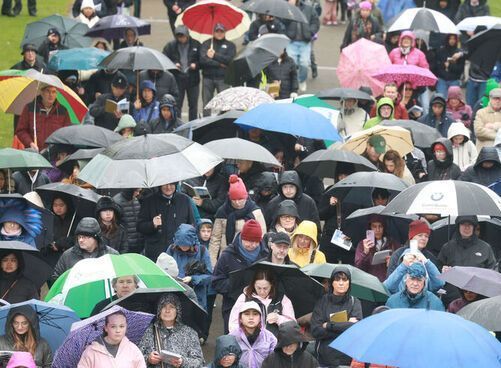In his 2023 novel, “My Father’s House,” Joseph O’Connor brought two Irish wartime heroes back to life.
One of them, Hugh O’Flaherty, a monsignor originally from County Kerry, has always been a somewhat obscure figure. The second in contrast, County Mayo’s Delia Murphy, was, O’Connor told us two years ago, “the closest thing 1940s Ireland had to a pop star” — although it was as Mrs. Delia Kiernan, the wife of a diplomat, that she was living in Nazi-occupied Rome.
O’Connor promised a trilogy and now the second book, “The Ghosts of Rome,” is in the bookstores.
“My Father’s House” got terrific reviews for the Frank McCourt Professor of Creative Writing at the University of Limerick.
Malcolm Forbes, writing in the Washington Post, called O’Connor’s 10th novel a “potent blend of excitement, suspense and intrigue” and a “gripping World War II-set drama featuring the unlikeliest of heroes, one whom the reader roots for every step of the way.”
The Australian-born, New-York based novelist Peter Carey, twice winner of the Booker Prize, said: “Few living writers can take us back in time so assuredly with such sensual density, through such gorgeous sentences.”
The theme of O’Connor as writer of historical fiction was taken up last month by Alex Preston in his New York Times review of “The Ghosts of Rome.” He cited the international success of “Star of the Sea” (2002) and “Redemption Falls (2007), describing them as “profoundly, peculiarly readable — delivering the punch of genre fiction while offering more subtle literary pleasures.”
The reviewer said, “O’Connor has often been likened to the great Irish modernists for the lyricism of his voice-driven novels. But ‘The Ghosts of Rome’…also situates him within a broader European tradition of memory and moral reckoning, one that returns again and again to World War II.”
Preston concluded, “What emerges is not just a wartime thriller, though it is that, but a meditation on how we remember, how we resist and how, even in the darkest times, humanity endures.”
The Irish Echo asked O'Connor some questions recently about "The Ghosts of Rome."
“The Ghosts of Rome” is the second book of your trilogy. Would you suggest to someone who hasn’t read “My Father’s House” to get that first, or does it matter?
Readers who’ve read “My Father’s House” might spot back-references in “The Ghosts of Rome” but the two novels are designed as standalone books. People from one novel appear in the pages of another, strolling in and out, sometimes quarreling. Throughout the books, all the most important characters are activists of “The Choir,” my fictional version of the Rome escape line set up and led by Irish priest Msgr. Hugh O’Flaherty to help fugitives from fascism, including escaped Allied prisoners. Hugh is the central protagonist of “My Father’s House,” a book in which he meets and begins a friendship with a troubled young Italian war widow, Countess Giovanna Landini. In “The Ghosts of Rome,” Giovanna – her friends nickname her “Jo” because of her fondness for Jo March in “Little Women” – steps into the spotlight of her own book.
Tell us more about her.
Giving Jo a story of her own felt a pleasure and an honor. I wrote “The Ghosts of Rome” in late 2023 and throughout 2024, a time when the world had troubles aplenty, so it was good to be reminded every day as I sat down at the desk that there are now and have always been people of Jo’s values and strengths. People who give you hope.
She is a tough, kind, independently minded woman, funny and disobedient, frail and courageous, indomitable of spirit, a great friend to have in your corner. Sustained by a religious faith that is not shared by all those who love her, and by a passion for art and music and beauty, she is a woman who brings people together around the lasting things of life.
My heroine and favorite artist is Patti Smith. There’s a bit of Patti in Giovanna.
By way of contrast, did Naziism make Gestapo chief Paul Hauptmann bad or was there something in his character in your view that drew him to the ideology and allowed him to rise within the state apparatus?
This is a question that I think is best be answered by the reader. My own thinking on it is that there was a moment in Hauptmann’s younger life when he could have gone either way but, in opting for fascism, he condemned himself to never being able to get back out of it. To quote Bob Dylan, he had no direction home.
As you write further into the books do you feel you’ve gotten to know the characters better, including those based on real people, like Delia Murphy Kiernan and Hugh O’Flaherty?
Yes, I feel I know Delia and Hugh pretty well at this stage. Their voices often come into my mind during everyday life and I find myself wondering what they would think about this or that item on the news. Worryingly, they sometimes tell me.

The New York Times’ reviewer of “The Ghosts of Rome” said you've used all of your “polyphonic talents” when inhabiting its multiple characters. Presumably those talents come naturally to some extent, but as a teacher do you have tips for a writer starting out on how to develop their techniques in that area?
Words are sounds before they are anything else. Our first experiences of language are memorable because of what we hear, not because of what they mean. So, it’s important to listen out for musicality when people are speaking. The way a New Yorker speaks is not the same as the way a Donegal person speaks, or someone from Sydney, and so on. So a writer always needs to be listening.
If I had to pick one favorite piece of writing – which thank God I don’t – it would be Brian Friel’s short masterpiece “Faith Healer.” It’s wise, funny, sad, moving, strange, poetic, highly accessible. Anyone who has seen it on stage will never forget it. Every year I ask my writing students at University of Limerick to read it. One of the things that’s most compelling about “Faith Healer” is that it’s essentially the same story told by three different characters. Which means, of course, that it isn’t the same story at all. Each person’s perspective on the events of the plot is an individual, unique experience. All of my own books, from “Star of the Sea” onwards, have tended to have multiple characters or perspectives, hence my writing this trio of Rome novels through which the same people come and go
The chase scene can in some hands turn out a bit tedious. How have you made it effective? Do you have any cinematic or literary inspirations?
A novel set in an occupied city is almost inevitably going to have chase scenes, so it’s important to try to write them as though nobody has ever written them before. And it’s vital to make a chase scene specific to the place in which it’s happening so that the reader sees and feels the texture of that place. My favorite chase scene of all time is the car chase in the movie “Bullitt,” in which Lieutenant Frank Bullitt in his Highland Green 1968 Ford Mustang GT goes after a couple of tough guys in a black Dodge, bumping up and down the hills of San Francisco. Fantastic.
In answer to a question last time about the use of comedy, you answered that humor can add “texture and nuance” to the darkness. Might the same be said about beauty and beautiful objects in the books in context of the horror of war?
Yes, any novel set in Rome needs to include beautiful objects and artworks if it wants to be realistic. The atmosphere of the city is very much bound up with its past: dark chapels, fallen temples, Puccini’s “Tosca”, the breathtakingly extraordinary paintings of Caravaggio and Fra Lippo Lippi. It’s wonderful for the writer about Rome to have these deep wells of beauty and light to draw from, particularly when the background subject matter of the plot is dark.
You dedicate “The Ghosts of Rome” to your father and stepmother. Could you say something about them?
My father Seán taught me to read when I was 4, before I started going to school. He’s from Francis Street in the Dublin Liberties and is rightly very proud of the fact. He’s a big reader, loves poetry, has a fine tenor voice, sings “Che Gelida Manina” or “She Moved Through the Fair” at family occasions. He reads the psalms every morning but has his own special copy of the Bible in which he has crossed out Old Testament passages mentioning violence, vengeance, prohibitions, disliking other religions, and so on. That’s a lot of crossing out.
He was raised Catholic but is now a Presbyterian, as is Viola my stepmother, who’s from Bangor, Co. Down. The most remarkable of many wonderful things about Viola is that in the 50 years I’ve known her, I’ve never seen her lose her temper or heard her say an unkind word about anyone. When she finally does, it’s going to get savage.
You said last time, when “My Father’s House” was first published, that you fell in love with Rome while doing research for it. Have you made more trips back since?
Yes, I’m in Rome every few months. We’re going again in May. Usually, we stay in the same neighborhood, Trastevere, and often in the same apartment. There’s a lovely bookshop nearby, the Almost Corner (via del Moro, 45), set up by an Irishman, the late Dermot O’Connell. We feel, quite spuriously, that we’re sort of locals by now because we go to the same restaurant (Roma Sparita, Piazza di Santa Cecilia, 24) every Saturday night when we’re there. After two glasses of red wine, I speak Italian fluently. But doesn’t everyone?
I’ll be reading and speaking at a conference to mark the 400th anniversary of the founding of the monastery and college at Sant’Isidoro a Capo le Case by Luke Wadding from Waterford. I’d like to make another visit to the remarkable place that is the basilica of San Clemente, where Kerry-born Dominican Father Paul Lawlor, a noted archaeologist and scholar, is still unearthing marvels. Also, I’m visiting La Foce, which is near Siena, to do a few weeks of research and writing. It’s the estate where the Irish-British-American writer Iris Origo lived with her husband and saved many escaped Allied prisoners from the Nazis.
“The Ghosts of Rome” is published by Europa Editions; 383 pp.; $28.









